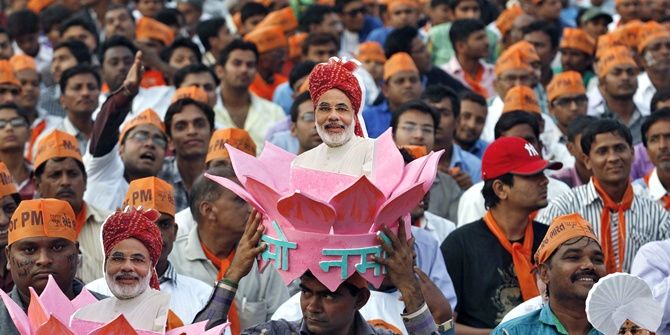Narendra Modi’s resounding re-election last week won’t be the last, according to Abhimanyu Chandra. Through a blend of Hindu nationalism and authoritarianism, Modi’s BJP party is slowly bending India’s public institutions and civil society to its will, marginalizing opposition and endangering the country’s democracy.

Narendra Modi was sworn in as the Prime Minister of India for a second term (2019-2024) last week (30 May). The swearing-in ceremony also informally marked Modi’s likely swearing in for a subsequent third term (2024-2029).
Like the United Kingdom, and unlike the United States, the Indian system does not carry term limits. Modi’s second term likely guarantees him a third not because of policy wins that he may accomplish. It does so because of the destruction of the institutional-civic bulwarks of Indian democracy that, picking up from a first term characterised by authoritarianism and Hindu nationalism, he will almost certainly be presiding over during the next five years.
Under the last five years of the Modi government we have witnessed the erosion of key Indian institutions. The impartial functioning of the judiciary and law enforcement has been compromised. For example, as the scholar Christophe Jaffrelot has shown, Modi’s most powerful state-level leader, Yogi Adityanath, has had criminal cases against himself withdrawn; the state police under Adityanath’s watch has collaborated with Hindu nationalist groups in violence against minorities, rather than preventing the violence or booking the perpetrators. Meanwhile the highly-regarded Election Commission of India has increasingly been seen as acceding to the wishes of Modi’s party, the Bharatiya Janata Party (BJP), rather than acting neutrally as it is supposed to do. The BJP has politicised the military for partisan gain. Authoritarianism sprinkled with Hindu nationalism has been responsible for the undermining of these and other key institutions.
A more even mix of authoritarianism and Hindu nationalism has additionally denuded, and denuded space for, civic life. Those who disagree with the BJP are termed “anti-national”. The BJP, with its Hindu nationalist ideology, in a country where approximately 80% of the population is Hindu (whether consciously and in a self-identifying way, or not), sees huge political advantage in ceaselessly emphasising Hindu identity and reducing the country’s multifarious debates to Hindu versus non-Hindu. The party uses its vast, on-ground Hindu nationalist network—comprising training camps with participants in the millions, what one author has called “shadow armies”, schools, unions, and other outposts—for these purposes. And Hindu is increasingly equated with Hindu nationalist. The fundamental ways in which people relate with themselves and with each other is being changed in toxic ways. One BJP-friendly shadow army is the Bajrang Dal, expert in disrupting cultural events featuring those it deems to be anti-Hindu (that is artists, filmmakers, liberals—the late famous Muslim painter M.F. Hussain and the well-known Hindu filmmaker Deepa Mehta have been prominent targets). Such shadow armies now have more latitude than ever before. With the BJP’s embrace, they are making India more devoid of oxygen, more monochromatic.
The Indian zeitgeist today is much more strained compared to, for instance, the American predicament when Donald Trump was elected president in 2016. Unlike Modi and BJP and Hindu nationalism in India, Trump and the Republican Party do not possess at their behest thousands of training camps across the US, where millions of boys and men are given militaristic, white nationalist indoctrination and taught that minorities are their enemies. Trump has a cozy relationship with Fox News and various other news outfits but he is still faced with the investigative reporting of The New York Times and The Washington Post. Modi on the other hand is boosted by an overwhelming section of the national media which instead, of asking tough questions of the BJP, tends to busy itself with criticising the opposition. The Indian counterparts of the nationally and internationally read Times and the Post are the news website TheWire.in and the magazine The Caravan, which, in contrast, are read by a small, urban, liberal, Indian intelligentsia. In India the amount and sources of political funding is infamously opaque. Even so, many indicators suggest that the BJP’s wealth is preponderantly greater than its rivals’. American liberals had a lot to be concerned about when Trump won. Indian liberals have an awful lot more to be concerned about now that Modi has won, again.
The two processes in India from the last five years highlighted above—the weakening of key institutions, and the denudation of, and denudation of space for, civic life—will likely only speed up during Modi’s second term. These processes suit the BJP’s interests. As a consequence it is largely left unchecked by countervailing institutions. Dissenting voices are weakened. And with the recent elections, Modi and the BJP have only been vindicated and therefore emboldened. The BJP had won a stunning 282 out of the total 545 Lower House of Parliament seats in 2014, and has now won more, that is 303 out of the 545. Five years from now the currently weakened institutions may become puppet institutions. The currently frayed civic life may become irreversibly impaired. If stopping the BJP was difficult for the opposition parties this time around, it is structurally only going to become tougher five years from now. The BJP’s control over the media will have further tightened by then. Bureaucrats’ capacity for resisting the BJP’s partisan pressures will likely have diminished further.
Under these challenging circumstances, some hope comes from India’s intrinsic dynamism—it is home after all to 1.3 billion people, of the average age of approximately 29. The country is vast, continental—home to hundreds and thousands of languages and dialects. And Indian democracy is home to a near-constant electoral contest, with elections taking place at the state and village levels at a frequent tick. Modi and the BJP possess discursive hegemony but even they may have to temper their excesses before this gargantuan, diverse population, and the pressure of local elections. Opposition parties in India’s multi-party system may put on a more energetic, more united effort five years from now. While no party at the national level seems individually capable of taking on the BJP—certainly not the currently weak and shell-shocked Indian National Congress—a coalition of parties, including those at the state and regional levels, may be able to. Yet, that hope feels like optimism bordering on wishful thinking.
After all, real electoral contest can exist only when key democratic institutions such as the media impartially carry out their job. When most or all have either been bought over, coopted, or intimidated, then the guardrails have fallen. In such a scenario what fair competition can exist? Real electoral contest can exist only when there is civic space, a breathing room for a contest of ideas. But if Hindu nationalists for instance assassinate opposing voices then what debate can happen? The recent Indian elections which have given Modi a second term cannot be seen within the logic of “elections come and go”, and “one party wins this time, another party wins the next time”. This election has been a case of a democratic verdict for an authoritarian outcome—ironically in, of all places, the world’s largest democracy. Whether Modi implements effective policies or not during his second term, his authoritarianism and Hindu nationalism will likely give him at least a third term.
About the author
Abhimanyu Chandra is a Ph.D. student in South Asian Languages & Civilisations at The University of Chicago. He has an M.Phil. in Modern South Asian Studies from the University of Cambridge, and a B.A. in Political Science from Yale College. He has published previously with The Huffington Post, Eurasia Review, Caravan Magazine, TheWire.in, and a variety of other organisations. He is on Twitter at @_a_chandra.
Note: This piece gives the views of the author, and not the position of the LSE Religion and Global Society blog, nor of the London School of Economics.






nice article
well constructed article.. i love this
Very good article,keep the good work